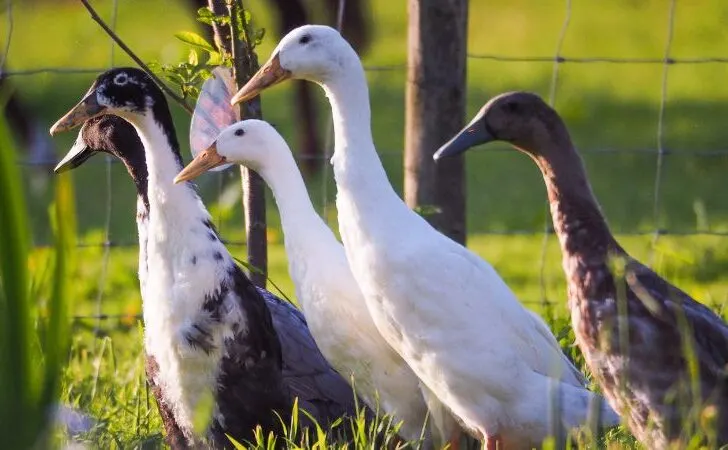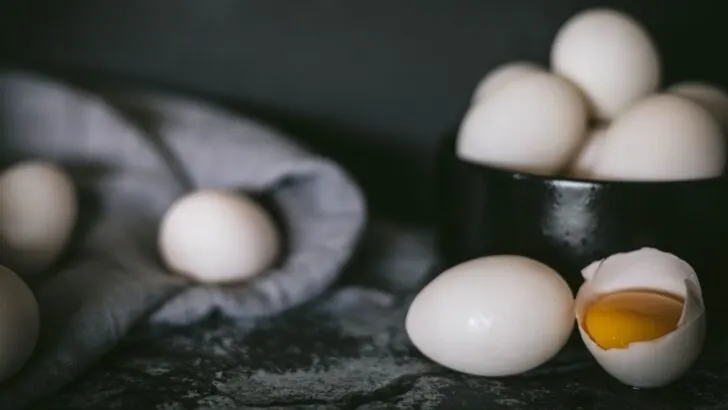The Indian Runner Duck is a unique breed of duck that stands upright. Instead of waddling, they actually move quickly over the ground. Almost like a bowling pin with feathers, they’re a lot of fun and an interesting addition to your homestead.

We’ve owned a lot of different duck breeds over the years and while we have settled on our favorite breed, the runner duck holds a special place in my heart. Our first group of ducklings we purchased in 2017 consisted of a hodgepodge mixture of breeds and one of those was an Indian Runner Duck we named Shivers.
Runner ducks run, they don’t waddle, and they are known for their upright appearance akin to a scared bowling pin with feathers or a penguin. A lot of fun to have around the homestead, they will live around 8 to 12 years.
History of Runner Ducks

Coming from the East Indies, runner ducks have a long history. Ancient carvings in Java depict this duck breed dating back two thousand years or more. Noted by Europeans in mid-19th century, their history is much older than that.
Flocks of Indian Runners were sent out to rice paddies by herders in Southeast Asia during the day to forage and keep insects and pests at bay. At night, they would be herded back into bamboo or clay enclosures to keep them safe.
Over time this allowed for a selection of birds that had excellent foraging skills, could walk well, and laid an abundance of eggs.
In the 16th century this breed almost became extinct because they were crossbred extensively with other breeds of domestic ducks. They currently have a “recovering” status with the Livestock Conservancy.
Called “Penguin Ducks” by Harrison Weir, they made their way to Britain in the mid nineteenth century. Brought to the United States, and still referred to as Penguin Ducks, this breed was very popular among homesteaders in the late 1800s.
Indian Runner Duck Appearance

As mentioned, they were often referred to as penguin ducks because of their upright appearance. These ducks do not waddle, but rather run, and can actually run quite quickly.
Runner ducks have tight feathering and come in a larger variety of colors than any other duck. The colors recognized by the American Standard of Perfection are black, buff, chocolate, Cumberland blue, fawn and white, grey, and penciled.
Their bills are very straight and can be yellow, orange, or black. They are flightless, like most domestic duck breeds.
Their heads are slender, with eyes set quite high on their head. Their legs are set very far back on their bodies which enables them to have the upright appearance that they do. As with all domestic ducks, drakes will have a curly tail feather or two while the hens do not.
Raising Runner Ducks for Eggs

While it is said that runner ducks can lay blue-green pastel eggs, we’ve owned several and their eggs have always been white. That said, they are good layers of jumbo eggs with a high egg production anywhere between 200 and 300 eggs per year.
The eggs are large and weigh on average 3 ounces. Like all duck eggs, these eggs are fantastic for baking and other uses where you want some added moisture. But, we like them just as they are fried up for breakfast, too.
Ducks will lay eggs regularly for about 4 to 5 years before their production starts to slow down significantly. They will still lay after this time period, and the quality will still be there, but they won’t lay near as many eggs.
This breed does not have very good maternal instincts but will make and actually use a nest. So, if you want to raise ducklings, while the hen may hatch them for you, her job will be done and you’ll need to put the baby ducks in a brooder and raise them yourself.
Raising Indian Runner Ducks for Meat

Their small size means this duck is not prized for its meat as there isn’t a lot of it. But, they do have a surprising amount of meat on them considering their size.
These ducks only get to around five pounds in weight, yet they stand anywhere between 21 inches and 26 inches tall so again, they don’t produce a lot of meat and definitely won’t feed a crowd.
Indian runners will produce enough meat to feed about two people and the meat is said to taste more like a wild duck and not so much like a domestic duck. This duck actually has little fat on it, unlike some other breeds, but it isn’t something I would suggest raising primarily for meat production.
Raising the Indian Runner Duck
Runner ducks are a lot of fun to raise. They are excellent foragers and will do a great job keeping snails, slugs, and the like out of your garden without tearing up your plants (assuming they’re not tender seedlings).
This breed likes to roam and prefers not to forage near their coop. We have run kept our runner ducks without issue, but we do have a very large space for them to roam. If you’re limited on space, this may not be the breed for you.
This breed does well with both hot and cold temperatures, though we did have a not-so-smart drake freeze himself to the ground getting a little overzealous with the water in the dead of winter. I got him thawed…
Like most domestic duck breeds, they are very hardy and healthy. They don’t require any specialized treatment or care, they just need brooded if you’re raising ducklings as mama will not likely take care of the babies once they hatch.
This is a great breed to raise on a homestead, given the opportunity, but socializing with them and working with them from hatch is important. While this breed of duck is very friendly and docile, they are also very skittish of humans, so working with them from the start is a good idea if you don’t want them to run around like scared bowling pins any time they see a human.

